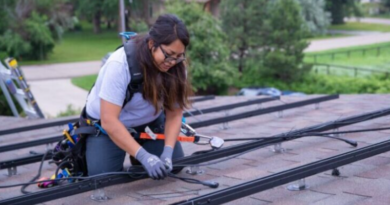U.S. researchers testing dual-use solar snow fence
In colder regions, like in Minnesota, high winds and snowfall can lead to drifts that build up on roadways, making them hazardous and difficult to clear. These regions often build snow fencing along the roads to block the drifts from accumulating on the pavement.
Now, researchers at North Dakota State University and the Minnesota Department of Transportation are evaluating adding solar panels to the snow fencing, adding the dual benefit of adding clean energy production to an already developed space.
The solar fence is comprised of six-inch-wide solar panels with spaces in between. The fence functions by blocking snow drifts. A 100-foot section of fence can produce about 20 kWh to 30 kWh per hour during the daytime in the northern climate, said Mijia Yang, associate professor at North Dakota State and lead researcher on the project.
“They’re producing enough energy with this 100-foot section to meet the home energy needs of a typical household,” Yang told Minnesota Public Radio. “And that was pretty eye-opening. If you did this across a mile, that would be 50 homes.”
The Minnesota Department of Transportation (MnDOT) maintains about 36 miles of composite snow fence across the state, part of a network of 177 miles of various types of windbreaks.
Some models of the solar fence developed by MnDOT also have electricity-powered heated mats powered by the PV array. This may help the department manage snow drifts, which can reach 10 feet high.
Economic analysis of the PV highway-side fence showed that it could reach breakeven in about four years, while the fence could last well over 20 years.
The next stage of the research is to develop a plan for where to send the electricity production. One possibility would be powering electric vehicle charging stations at roadside rest stops. MnDOT is also mulling selling the generation to electricity off-takers, generating more revenue for the department.
Source : pv-magazine.com




